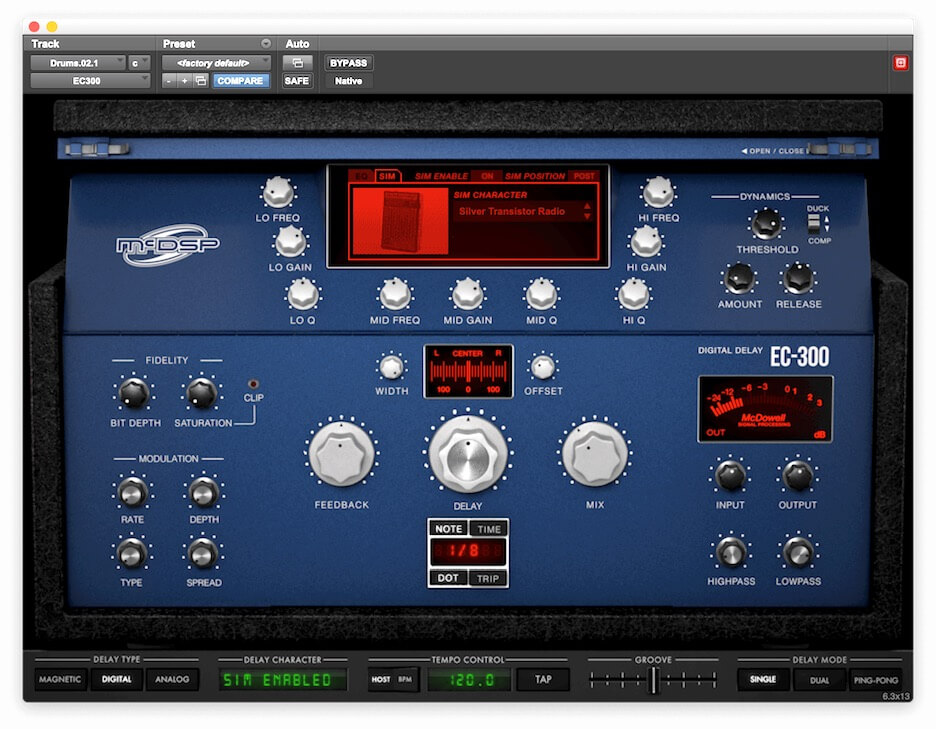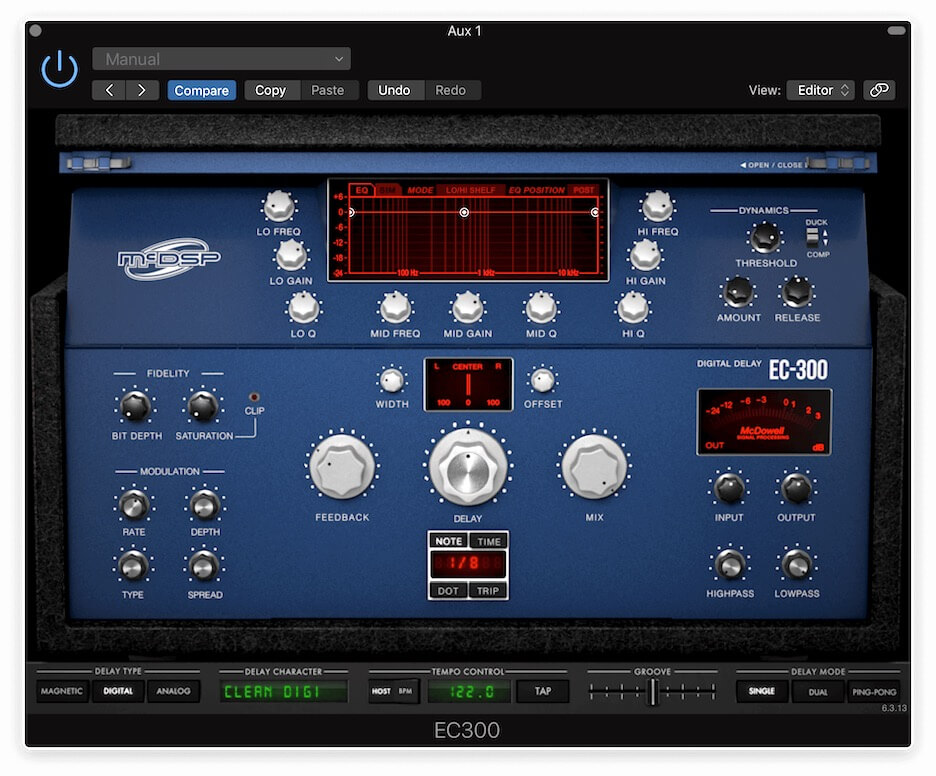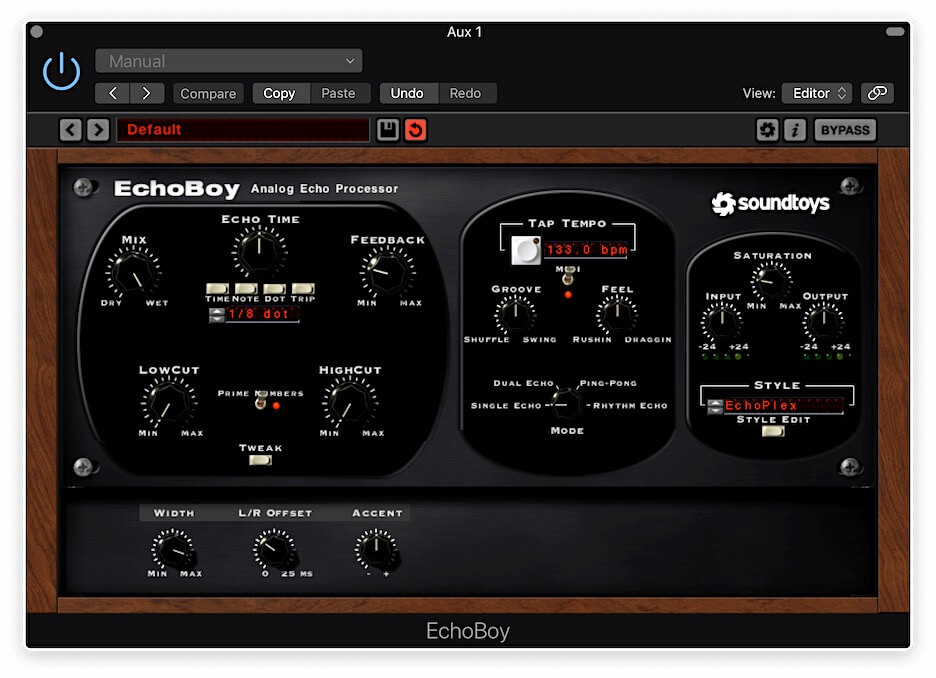Sometimes you discover during the mix that a track that you thought was well recorded is lacking in some way when you’re mixing. When that happens, there may be an opportunity to use effects processing to imporve it. In this excerpt from “Tony Maserati Mixing Jason Mraz,” we see Tony use a delay to subtly adjust the rhythmic complexity of a guitar part.
We join the action with Tony listening to some soloed elements of the mix—acoustic guitar, electric guitar, Wurlitzer electric piano and vocals. He says he’s not happy with the feel of the acoustic guitar, which is playing reggae-style accents on the upbeats.
Into the Echo
Tony opens up a stereo instance of a Soundtoys EchoBoy, an extremely versatile delay plug-in, on an aux and starts experimenting with different settings. He sets it in Single echo mode, which means it’s applying the same delay time to both the left and right.

After a bit of tweaking, Tony ended up with this setting on EchoBoy for the guitar track.
EchoBoy includes some unique features, including its Feel section, which Tony experiments with initially. The Feel controls include knobs called Rushin’ and Draggin', which delay or advance the echo taps so that they’re not directly on the beats. It also features a knob called Groove, which lets you inject either swing or shuffle feels into the taps.
He tries turning the Feel knob to the Draggin' side but ends up returning it to its default. Next, he hovers over the area where you set the note value of the delay when syncing to the host tempo. Initially, he has it set to an eighth-note delay, but he changes it to eighth-note triplets. A triplet subdivides each note into three equal parts.
You can hear the taps coming in on either side of the original note in the stereo image. He turns up the Feedback to get more repeats. Then, he brings in the LowCut filter to take away some of the bottom end of the delayed notes. He also puts the HighCut filter in, to make the delayed notes a little rounder sounding.
Finally, he once again experiments with the Groove controls in EchoBoy and turns the Mix control down a little, which makes the effect more subtle.
Offbeat
In the excerpt, one of the things you saw Tony do was try different feedback settings. The feedback parameter is crucial because it controls how many taps are created when a note, beat or other signal is input into the delay. When set to the minimum (which is typically the default), you’ll only hear one tap. If you turn it up higher, you can create more involved rhythmic delays, because taps may overlap subsequently delayed notes and as well as each other. If you feel like the delay is making the track sound too busy, try reducing the feedback before you try changing the delay time.
Generally, when you have an effect on an aux, you control the ratio of wet-to-dry signal by how far you turn up the aux send. You could also turn up or down the output of the aux return track to affect it, or you could bring down the mix control on the delay like Maserati did, but it’s probably best to use the send knob primarily.

The top waveform was created when a simple quarter note pattern was delayed with an eighth-note setting and the feedback at minimum. The image below is with the feedback turned up to a little less than 50%. Notice how much more complex the audio becomes.
Oh, the Complexity
You can use a delay to make a simple rhythmic pattern more interesting. Depending on the delay settings the listener may not even notice that you’re using a delay. If that’s your goal, you should probably choose a digital delay plug-in. Its taps are sonically the same as the source, whereas on an analog or tape-delay emulation, with each successive tap, the audio degrades a bit to match what would happen on the original hardware.
Conversely, if you don’t care if it sounds like an effect, then you can go for settings in which the tone of the taps varies a lot from the source. A lot of delays now include saturation, tape emulation and other ways to alter the delayed signal. McDSP’s EC300 delay plug-in even lets you apply SIMs (Simulated Impulse Responses) sampled from a variety of devices such as old cassette recorders, telephones and fax machines to create unique-sounding taps.

The EC300 lets you route the delayed signal through a variety of sampled devices.
When using delays rhythmically, it’s easiest to sync the plug-in to the song’s tempo (assuming you recorded your project to a click). That way, the new rhythms created by the effect will be in time. You could do it manually, adjusting delay time and using your ear, but it’s harder to get as much precision.
You’ll have to experiment with different delay settings and configurations. The rhythm of the delayed part will be a function of that of the original and what you set for the delay. Generally, if the original doesn’t have a syncopated rhythm, try using a delay time that’s either triplet or dotted note value. If the original part is already syncopated, you can use straight delay values like quarter-note, eighth-note and sixteenth note.
The following shows an example of using a delay to add complexity to a conga loop.
EX 1a: Here’s the loop by itself. It’s syncopated, but simple.
EX 1b: The conga delayed by a stereo instance of McDSP EC300 on an aux track. The delay is set in its clean Digital mode and it’s width control is turned down so that the taps are panned similarly to the original. Delay time is set to eighth-notes.
EX 1c: Same as 1b except that the feedback control is now set at 46%, which creates a more complex pattern.

The settings of the EC300 for example 1b.
The Dotted Eighth-Note Trick
One of the more fun and effective delay techniques is to apply a dotted-eighth note delay to an eighth-note instrument pattern that’s played pretty evenly. With that setting and some adjustment of the mix and feedback levels, it sounds like the instrumentalist is playing a lot faster. The technique works great on guitar or a relatively staccato sounding lead line on any instrument.
Ex. 2a: In this example, you’ll hear a steady eighth-note lead synth pattern. It sounds simple and not very musical.
Ex. 2b: Here’s the same section, but this time the synth has EchoBoy applied via aux in Single Echo mode with a dotted-eighth delay time and the feedback up to about 25%

Here’s the settings on EchoBoy for example 2b.
You probably only want to use this technique occasionally, but it’s a cool thing to have in your bag of processing tricks.